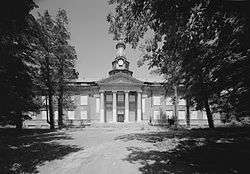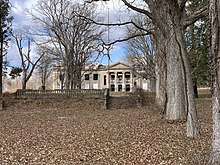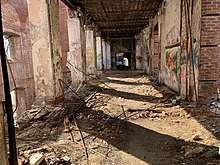Tome School
The Tome School is a private school in North East in Cecil County in the U.S. state of Maryland. Founded by Jacob Tome, it is one of the oldest schools in Maryland. It enrolls grades K - 12. As of 2019, its principal is Christine Szymanski.
Tome School for Boys Historic District | |
 | |
  | |
| Location | Bainbridge Naval Training Grounds, Port Deposit, Maryland |
|---|---|
| Coordinates | 39°36′10″N 76°6′26″W |
| Area | 30 acres (12 ha) |
| Built | 1900 |
| Architect | Boring & Tilton |
| Architectural style | Colonial Revival, Georgian Revival |
| NRHP reference No. | 84001760[1] |
| Added to NRHP | May 16, 1984 |
History
Port Deposit
The Tome School for Boys, originally located on Main Street in Port Deposit, Maryland, in Cecil County, on the east bank of the Susquehanna River was founded by Jacob Tome (1810-1898), as a nonsectarian college preparatory school for boys. It opened for boarders and received its first students in 1894. It was part of a system of schools collectively known as the Jacob Tome Institute that began with kindergarten and extended through high school.[2] Situated in the northeast corner of the state, the Tome School was immediately popular, attracting almost all the students from the town of Port Deposit and many from outside, throughout Maryland, Pennsylvania and neighboring states.[3]

Tome left the school an endowment at his death in 1898.[4] Under the direction of his widow, Evalyn N. Tome, the Board of Trustees hired Scottish immigrant James Cameron Mackenzie (1852-1931), to direct the school. MacKenzie, one of the most important late 19th-century secondary school educators, proposed using the endowment to create a separate upper-level boarding school for boys. Two hundred acres on the bluff above the town of stone granite buildings and the broad picturesque Susquehanna River were purchased for this purpose. MacKenzie in turn consulted with Robert Swain Peabody (1845-1917), of the prominent Boston architectural firm of Peabody & Stearns, concerning the design of the new Jacob Tome Institute.[3]
Following a design competition in 1900, supervised by Peabody, the Board of Trustees selected designs by partner architects William Boring (1859-1937), and Edward Lippincott Tilton (1861-1933), co-designers of the U.S. immigration station at Ellis Island in New York harbor and other significant structures, in the then popular beaux arts architectural style.[3] Over the next five years, stone buildings were built on the bluffs above Port Deposit using its famous local Port Deposit granite overlooking the Susquehanna River. The tree-lined streets of the campus were designed by nationally well known landscape architect Frederick Law Olmsted (1822-1903), who had also designed New York's Central Park and converged at the steps of Memorial Hall.[4] Olmsted selected well-known landscape architect Charles Wellford Leavitt (1871-1928), to design the school's gardens.[3][5] By 1902, the school had more than a dozen buildings and an endowment of $2 million ($59,100,000 today[6]). Thirteen of these buildings survive: Memorial Hall, three dormitories (Jackson, Madison, and Harrison), the Chesapeake Inn dormitory and dining hall, the Director's residence, the Monroe Gymnasium, and six Master's cottages.[7] Erika L. Quesenbery, author of United States Naval Training Center, Bainbridge, wrote that Memorial Hall was the school's "centerpiece".[8]
In the early 1900s, Tome played football annually against The Baltimore City College, the third oldest public high school in America, founded 1839, and with an interscholastic football team program dating back to the 1880s and had several other schools and colleges on its schedule.[9] The rivalry was fairly even. The City's Collegians beat Tome 5-0 in 1903 and 11-8 in 1904, but Tome won 32-0 in 1912 and 37-0 in 1915. Other rivalries also were versus the Baltimore Polytechnic Institute, the mathematics/science/technology public high school, established 1883 that was also City College's arch-rival. These were the few other public secondary schools, in addition to several other private or religious schools, institutes and academies in the region offering worthy sports and academic competition.
In 1906, school director Abram W. Harris, along with Phi Beta Kappa members on the Tome School faculty, organized Alpha Delta Tau fraternity, which later became the Cum Laude Society.
The school enjoyed a prestigious reputation for a number of years. Its students included R. J. Reynolds, Jr. (son of R. J. Reynolds) as well as children of the famous financial / business Mellon and Carnegie families.[4]
The school property and buildings were listed on the National Register of Historic Places as a historic district in 1984.[1]
USNTC Bainbridge
After thriving for several decades, the Jacob Tome Institute fell into difficult financial straits during the Great Depression of the 1930s and closed in 1941. The following year, just after the United States entered World War II, President Franklin Delano Roosevelt approved the acquisition by condemnation[10] of the property and land from 70 surrounding farms for use by the United States Navy as a training center. The institute's buildings were renovated for use by the Naval Academy Preparatory School to prepare future midshipmen for the U.S. Naval Academy further south at Annapolis, Maryland.[3] USNTC Bainbridge was activated on October 1, 1942, and operated throughout World War II, Korean War and Vietnam War, and the Cold War era. It closed as a military facility on March 31, 1976. During 34 years of operation, USNTC Bainbridge, (named for early 19th century naval hero William Bainbridge) graduated over 500,000 recruits.[4]
For over a decade, from 1979-1991, the Susquehanna Job Corps Center occupied the campus. In 2000, the site was transferred to the State of Maryland, which subsequently turned it over to the Bainbridge Development Corporation.[3]
Meanwhile, the Tome School moved back to its original site on Main Street in Port Deposit. In 1971, the Tome School moved to a new, hundred-acre campus in North East, Maryland.

On September 21, 2014, a fire damaged the old campus' Memorial Hall, destroying its clock tower.[11] In 2018, a local newspaper wrote of the old campus that Van Buren, Madison, and Monroe Halls remain, while the headmaster’s house "is badly vandalized but standing", and Jackson Hall "like Memorial Hall, is a burned-out hulk." [11]
On May 6th, 2020, a fire broke out at the former Tome School resulting in one of the buildings, a wooden/stone home-style build, to be completely burned to the ground.[12]


Academics
The co-educational school enrolls students from kindergarten through twelfth grade. The curriculum provides a broad liberal arts education in an environment emphasizing academic success, high standards of personal behavior, and full participation in school life. The student body is divided among three schools:
- Lower School (K-4). Students begin French and Spanish language study in first grade.
- Middle School (5-8). Students are required to take Latin study in the seventh grade through eighth grade.
- Upper School (9-12). Students concentrate on a traditional college prep academic program.
The current Head of School is Christine Szymanski.
Extracurricular activities
- Varsity Sports: Basketball, Soccer, Lacrosse, Cross Country, Tennis, Volleyball, Field Hockey, Softball, Baseball, Golf and Cheerleading.
- Junior Varsity Sports: Basketball, Soccer, Cross Country, Field Hockey, Volleyball, and Tennis.
- Organizations and Clubs: National Honor Society, Junior National Honor Society, Key Club, Builders Club, Middle School Chorus, Orchestra, Student Government, Chess Club, Environmental Club, Envirothon Team, and Student Literary Magazine.
Notable alumni, faculty, and staff
- Abner Biberman, actor, director, and screenwriter.
- Forrest Craver, Football head coach, director of sports.
- Kent Curtis, American novelist, illustrator, composer, yachtsman, and teacher.
- James Devereux, United States Marine Corps general, Navy Cross recipient, and United States congressman.
- Eric P. Hamp, linguist.
- William S. James, Politician.
- Harry LeGore, American football and baseball player, Maryland state legislator and businessman.
- Norman T. Kirk, Surgeon General of the United States Army.
- Jim Meade, American football player and coach.
- James Rouse, founder of The Rouse Company, attended for one year.
- Lansdale Sasscer, U.S. Representative from Maryland[13]
References
- "National Register Information System". National Register of Historic Places. National Park Service. July 9, 2010.
- Richard Walsh and William Lloyd Fox (editors) (1983). Maryland: A History 1632-1974. Maryland Historical Society, Baltimore. ISBN.CS1 maint: extra text: authors list (link)
- Massey Maxwell Associates. "Jacob Tome Institute, Memorial Hall, Tome Road, Port Deposit, Cecil County, MD". www.loc.gov. Historic American Buildings Survey/Historic American Engineering Record/Historic American Landscapes Survey. Retrieved 22 December 2014.
-
- A History of Maryland’s Lower Susquehanna Region Archived 2006-10-01 at the Wayback Machine
- Quesenbery, Erika L. (2007). United States Naval Training Station, Bainbridge. Charleston, S.C.: Arcadia Publishing. p. 13.
- Federal Reserve Bank of Minneapolis. "Consumer Price Index (estimate) 1800–". Retrieved January 1, 2020.
- "Tome School for Boys Historic District".
- Quesenbery, Erika L. United States Naval Training Center, Bainbridge. Arcadia Publishing, 2007. ISBN 0738544205, 9780738544205. p. 13.
- Leonhart, James Chancellor (1939). One Hundred Years of the Baltimore City College. Baltimore: H.G. Roebuck & Son. pp. 203–210.
- Knauss, Christopher. Maritime Cecil County (Images of America). Arcadia Publishing, 2007. ISBN 978-0-7385-4446-5. p. 38-39.
- Whig, Erika Quesenbery Sturgill Special to the. "Old Tome School landmark gutted 4 years ago". Cecil Daily. Retrieved 2020-02-08.
- "Bainbridge Fire: Crews Fighting Port Deposit Blaze". Havre de Grace, MD Patch. 2020-05-06. Retrieved 2020-05-07.
- "SASSCER, Lansdale Ghiselin, (1893 - 1964)". Biographical Directory of the United States Congress. Retrieved December 21, 2012.
Further reading
- The Tome School for Boys: An Endowed Preparatory School. Tome School, 1910. Profile at Google Books.
- Baker, Thomas Stockham. Tome School for Boys, Port Deposit, Maryland., 1st November, 1909. 1909. 4 pages. Profile at Google Books.
External links
| Wikimedia Commons has media related to Jacob Tome Institute. |
- The Tome School
- The Tome School parent reviews
- Tome School High School Alumni @ Reunion
- Tome School directions - mapquest.com
- Photos and History on eastghost.com
- Tome School for Boys Historic District, Cecil County, including photo from 1907, at Maryland Historical Trust website
- Jacob Tome Institute, Tome Road, between Bainbridge Road & Route 276, Port Deposit vicinity, Cecil, MD at the Historic American Buildings Survey (HABS), with additional material at , , , , , , , , , , and .